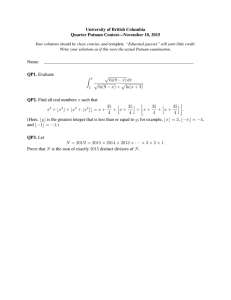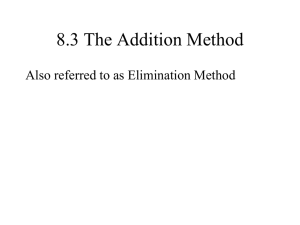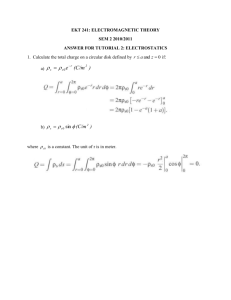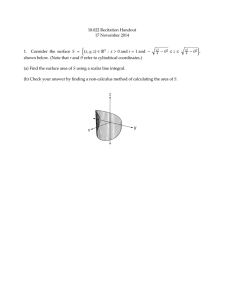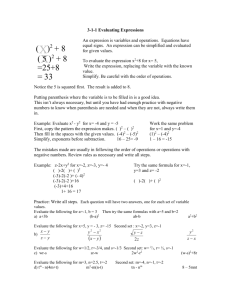Volume 15, 2011 5 ON FUNDAMENTAL AND SINGULAR SOLUTIONS OF THE SYSTEM
advertisement
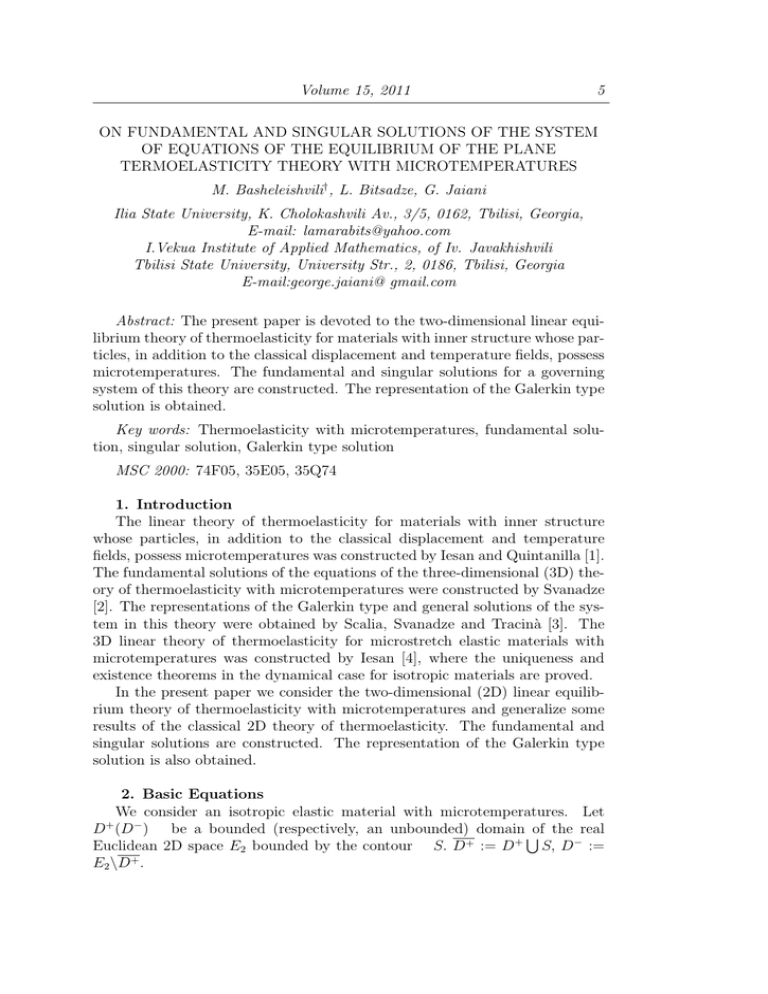
Volume 15, 2011 5 ON FUNDAMENTAL AND SINGULAR SOLUTIONS OF THE SYSTEM OF EQUATIONS OF THE EQUILIBRIUM OF THE PLANE TERMOELASTICITY THEORY WITH MICROTEMPERATURES M. Basheleishvili† , L. Bitsadze, G. Jaiani Ilia State University, K. Cholokashvili Av., 3/5, 0162, Tbilisi, Georgia, E-mail: lamarabits@yahoo.com I.Vekua Institute of Applied Mathematics, of Iv. Javakhishvili Tbilisi State University, University Str., 2, 0186, Tbilisi, Georgia E-mail:george.jaiani@ gmail.com Abstract: The present paper is devoted to the two-dimensional linear equilibrium theory of thermoelasticity for materials with inner structure whose particles, in addition to the classical displacement and temperature fields, possess microtemperatures. The fundamental and singular solutions for a governing system of this theory are constructed. The representation of the Galerkin type solution is obtained. Key words: Thermoelasticity with microtemperatures, fundamental solution, singular solution, Galerkin type solution MSC 2000: 74F05, 35E05, 35Q74 1. Introduction The linear theory of thermoelasticity for materials with inner structure whose particles, in addition to the classical displacement and temperature fields, possess microtemperatures was constructed by Iesan and Quintanilla [1]. The fundamental solutions of the equations of the three-dimensional (3D) theory of thermoelasticity with microtemperatures were constructed by Svanadze [2]. The representations of the Galerkin type and general solutions of the system in this theory were obtained by Scalia, Svanadze and Tracinà [3]. The 3D linear theory of thermoelasticity for microstretch elastic materials with microtemperatures was constructed by Iesan [4], where the uniqueness and existence theorems in the dynamical case for isotropic materials are proved. In the present paper we consider the two-dimensional (2D) linear equilibrium theory of thermoelasticity with microtemperatures and generalize some results of the classical 2D theory of thermoelasticity. The fundamental and singular solutions are constructed. The representation of the Galerkin type solution is also obtained. 2. Basic Equations We consider an isotropic elastic material with microtemperatures. Let D+ (D− ) be a bounded (respectively, an unbounded) domain ∪of the real Euclidean 2D space E2 bounded by the contour S. D+ := D+ S, D− := E2 \D+ . 6 Bulletin of TICMI ( ) ∂ ∂ Let x := (x1 .x2 ) ∈ E2 , ∂x := , . ∂x1 ∂x2 The basic homogeneous (i.e., body forces are neglected) system of the theory of thermoelasticity with microtemperatures has the form [1] µ∆u + (λ + µ)graddivu − βgradθ = 0, (1) k6 ∆w + (k4 + k5 )graddivw − k3 gradθ − k2 w = 0, (2) k∆θ + k1 divw = 0, (3) where u := (u1 , u2 )T is the displacement vector, w := (w1 , w2 )T is the microtemperature vector, θ is the temperature measured from the constant absolute temperature T0 (T0 > 0) by the natural state (i.e. by the state of the absence of loads), λ, µ, β, k, kj , j = 1, ..., 6, are constitutive coefficients, ∆ is the 2D Laplace operator. The superscript ”T” denotes transposition. We introduce the matrix differential operator A(∂x) :=∥ Alj (∂x) ∥5x5 , where Aαγ := µδαγ ∆ + (λ + µ) ∂2 , ∂xα ∂xγ Aα+2;γ+2 := δαγ (k6 ∆ − k2 ) + (k4 + k5 ) Aα,γ+2 := Aα+2,γ = 0, Aα5 := −β A5γ := 0, ∂ , ∂xγ A5;γ+2 := k1 ∂2 , ∂xα ∂xγ ∂ , ∂xα Aα+2;5 := −k3 A55 := k∆, ∂ , ∂xα α, γ = 1, 2, δαγ is the Kronecker delta. Then the system (1)-(3) can be rewritten as A(∂x)U = 0, (4) where U := (u1 , u2 , w1 , w2 , θ)T . e elj (∂x) ∥5x5 := AT (−∂x), where A elj (∂x) := The matrix A(∂x) :=∥ A Ajl (−∂x), will be called the associated operator to the differential operator A(∂x). Thus, the homogeneous associated system to the system (4) will be the following system µ∆u + (λ + µ)graddivu = 0, k6 ∆w + (k4 + k5 )graddivw − k1 gradθ − k2 w = 0, k∆θ + k3 divw + βdivu = 0. Volume 15, 2011 7 We assume that µ(λ + 2µ)kk6 k7 ̸= 0, where k7 := k4 + k5 + k6 . Obviously, if the last condition is satisfied, then A(∂x) is the elliptic differential operator [2]. 3. Matrix of Fundamental Solutions In order to investigate boundary value problems (BVPs) of the theory of thermoelasticity with microtemperatures by potential method it is necessary to construct a matrix of fundamental solutions to the governing system (4). Several methods are known for constructing the matrix of fundamental solutions of the systems of differential equations of the theory of elasticity and thermoelasticity ( see e.g., [2,5]). We introduce the matrix differential operator B(∂x) consisting of cofactors of elements of the transposed matrix AT divided on µ(λ + µ)kk6 k7 ̸= 0 : B(∂x) :=∥ Blj (∂x) ∥5x5 , where ∗ ∗ Bαγ := B11 δαγ − B12 ξα ξγ , ∗ B1γ+2 := B13 ξ1 ξγ , ∗ B2γ+2 := B13 ξ1 ξγ , B3γ ≡ B4γ ≡ B5γ ≡ 0, ∗ B11 := ∗ ∗ Bα+2,γ+2 := B33 δαγ − B34 ξα ξγ , ∗ B5γ+2 := B33 ξα , 1 ∆∆(∆ − s21 )(∆ − s22 ), µ ∗ B13 := − ∗ Bα5 := B15 ξα , ∗ B12 := ξα := ∂ , ∂xα λ+µ ∆(∆ − s21 )(∆ − s22 ), aµ β∆(∆ − s22 )(k7 ∆ − k2 ) βk1 ∆(∆ − s22 ) ∗ , B15 := , akk7 akk7 ∗ B33 := 1 ∆(∆ − s21 )∆∆, k6 ∗ B35 := k3 ∆∆(∆ − s22 ), kk7 ∗ B34 := α, γ = 1, 2, ∗ B55 ≡ B55 , 1 [(k4 + k5 )∆ − k7 s21 + k2 ]∆∆, k6 k7 ∗ B53 := − k1 ∆∆(∆ − s22 ), kk7 s22 := k2 , k6 kk2 − k1 k3 1 ∆∆(∆ − s22 )(k7 ∆ − k2 ), s21 := , a := λ + 2µ. kk7 kk7 Substituting the vector U(x) = B(∂x)Ψ into (4), where Ψ is a five-component vector function, we get ∗ := B55 ∆∆∆(∆ − s21 )(∆ − s22 )Ψ = 0. Whence, applying the method developed in [5], after some calculations, the vector ∆Ψ can be represented as ∆Ψ = − r2 (ln r − 1) K0 (s1 r) + ln r K0 (s2 r) + ln r + 4 2 − 4 2 . 4s21 s22 s1 (s1 − s22 ) s2 (s1 − s22 ) (5) 8 Bulletin of TICMI where K0 (sα r) is the modified Hankel function of the first kind and zero order, ( ) ∞ ( s r ) ∑ 1 ( sα r )2k 1 1 α K0 (sα r) := −I0 (sα r) ln + C +2 + + ... + 1 , 2 (k!)2 2 k k−1 k=1 I0 (sα r) := ∞ ∑ k=0 1 ( sα r )2k , (k!)2 2 r2 := (x1 − y1 )2 + (x2 − y2 )2 , α = 1, 2. As all the components of B contain the operator ∆, Substituting (5) into U = BΨ, we obtain the matrix of fundamental solutions for the equation (4) which we denote by Γ(x-y) Γ(x-y) :=∥ Γkj (x-y) ∥5x5 , where Γαγ (x-y) := −δαγ ln r λ + µ ∂ 2 Ψ11 + , µ aµ ∂xα , ∂xγ Γα+2,γ+2 (x-y) := δαγ Ψ33 (x-y) := Ψ11 := r2 (ln r − 1) , 4 K0 (s2 r) ∂ 2 Ψ33 − , k6 ∂xα , ∂xγ K0 (s2 r) + ln r Ψ35 − , k6 s22 k7 Ψ35 (x-y) := K0 (s1 r) + ln r , s21 Γ1,γ+2 (x-y) := − βk1 ∂ 2 Ψ13 , akk7 ∂x1 ∂xγ Ψ13 (x-y) := Ψ35 + Ψ11 , s21 Γ2,γ+2 (x-y) := − βk1 ∂ 2 Ψ13 , akk7 ∂x2 ∂xγ Γα5 (x-y) := β ∂Ψ15 , akk7 ∂xα ( ) k2 k2 Ψ15 (x-y) := − 2 Ψ11 + k7 − 2 Ψ35 , s1 s1 Γ5,γ+2 (x-y) := − k1 ∂Ψ35 , kk7 ∂xγ Γ55 (x-y) := Γ31 ≡ Γ32 ≡ Γ41 ≡ Γ42 ≡ Γ51 ≡ Γ52 ≡ 0, Γα+2,5 (x-y) := α, γ = 1, 2, k3 ∂Ψ35 , kk7 ∂xα K0 (s1 r) k2 − Ψ35 , k kk7 s21 := s22 := k2 > 0, k6 kk2 − k1 k3 > 0. kk7 We can easily prove the following Theorem 1 The elements of the matrix Γ(x-y) has a logarithmic singularity as x → y and each column of the matrix Γ(x-y), considered as a vector, is a solution of the system (4) at every point x if x ̸= y. e According to the method developed in [5], we construct the matrix Γ(x) := T e Γ (−x) and the following basic properties of Γ(x) may be easily verified: Volume 15, 2011 9 e Theorem 2 Each column of the matrix Γ(x-y), considered as a vece e tor, satisfies the associated system A(∂x) Γ(x-y) = 0, at every point x if e x ̸= y and the elements of the matrix Γ(x-y) have a logarithmic singularity as x → y. 4. Matrix of Singular Solutions In solving BVPs of the theory of thermoelasticity with microtemperatures by the method of potential theory, besides the matrix of fundamental solutions, some other matrices of singular solutions to equation (4) are of a great importance. Using the matrix of fundamental solutions, we construct the so-called singular matrices of solutions by means of elementary functions. τ We introduce the special generalized stress vector R(∂x,n)U, which acts on the element of the arc with the unit normal n = (n1 , n2 ), where τ τ R(∂x,n) :=∥ Rlj ∥5x5 , τ ∂ ∂ + (λ + µ)nα + τ1 Mαγ , ∂n ∂xγ τ τ ≡ Rα+2,γ ≡ Rα+2,5 Rαγ := δαγ µ τ Rα,γ+2 τ ≡ R5γ ≡ 0, τ Rα5 := −βnα , (6) τ ∂ ∂ + (k4 + k5 )nα + τ2 Mαγ , Rα+2;γ+2 := δαγ k6 ∂n ∂xγ τ τ ∂ ∂ ∂ − nα , α, γ = 1, 2, R5,γ+2 := k1 nγ , R55 := k , Mαγ := nγ ∂n ∂xα ∂xγ here τ := (τ1 , τ2 ), τα , α = 1, 2, are the arbitrary numbers. If τ1 = µ, τ2 = k5 , we denote the obtained operator by P (∂x,n). The operator, τ µ(λ + µ) k6 (k4 + k5 ) which we get from R(∂x,n) for τ1 = , τ2 = , λ + 3µ k4 + k5 + 2k6 we denote by N(∂x,n) and the vector N(∂x,n)U will be called the pseudostress vector. τ Applying the operator R(∂x,n) to the matrix Γ(x-y), we construct the so-called singular matrix of solutions τ τ R(∂x,n)Γ(x-y) := ∥ Mlj (∂x) ∥5×5 , where ∂ ln r (λ + µ)(τ1 + µ) ∂ ∂ 2 Ψ11 + (−1)γ+1 , ∂n aµ ∂s ∂x1 ∂x2 ] [ τ (λ + µ)(τ1 + µ) ∂ 2 Ψ11 ∂ τ1 , − ln r + M12 (∂x) := ∂s µ aµ ∂x22 τ Mγγ (∂x) := − 10 Bulletin of TICMI [ ] (λ + µ)(τ1 + µ) ∂ 2 Ψ11 ∂ τ1 ln r − , M21 (∂x) := ∂s µ aµ ∂x21 τ βk1 (µ + τ1 ) ∂ ∂ 2 Ψ13 , kak7 ∂s ∂xγ ∂x2 τ βk1 (µ + τ1 ) ∂ ∂ 2 Ψ13 , M2,γ+2 (∂x) := kak7 ∂s ∂x1 ∂xγ τ M1,γ+2 (∂x) := − τ β(µ + τ1 ) ∂ ∂Ψ15 β(µ + τ1 ) ∂ ∂Ψ15 , M25 (∂x) := − , kak7 ∂s ∂x2 kak7 ∂s ∂x1 [ ] τ k3 ∂ ∂Ψ35 ∂ ∂ ∂ k7 n1 K0 (s1 r) + (k6 + τ2 ) , := n2 − n1 , M35 (∂x) := kk7 ∂s ∂x2 ∂s ∂x1 ∂x2 τ M15 (∂x) := [ ] k3 ∂ ∂Ψ35 k7 n2 K0 (s1 r) − (k6 + τ2 ) , M45 (∂x) := kk7 ∂s ∂x1 τ τ k1 ∂ ∂ (K0 (s2 r) + ln r), M53 (∂x) := − k2 ∂s ∂x2 τ k1 ∂ ∂ (K0 (s2 r) + ln r), M54 (∂x) := k2 ∂s ∂x1 τ τ τ ∂K0 (s2 r) ∂ ∂ 2 Ψ33 ∂ − (τ2 + k6 ) + n1 [K0 (s1 r) − K0 (s2 r)], ∂n ∂s ∂x1 ∂x2 ∂x1 M33 (∂x) := τ ∂ ln r , ∂n τ M3γ (∂x) ≡ M4γ (∂x) ≡ M5γ (∂x) ≡ 0, M55 (∂x) := γ = 1, 2, ∂K0 (s2 r) ∂ ∂ 2 Ψ33 ∂ + (τ2 + k6 ) + n2 [K0 (s1 r) − K0 (s2 r)], M44 (∂x) := ∂n ∂s ∂x1 ∂x2 ∂x2 τ τ M43 (∂x) := − τ M34 (∂x) := ∂ ∂ 2 Ψ33 ∂ τ2 ∂K0 (s2 r) + (τ2 + k6 ) + n2 [K0 (s1 r) − K0 (s2 r)], 2 k6 ∂s ∂s ∂x1 ∂x1 τ2 ∂K0 (s2 r) ∂ ∂ 2 Ψ33 ∂ − (τ2 + k6 ) + n1 [K0 (s1 r) − K0 (s2 r)]. 2 k6 ∂s ∂s ∂x2 ∂x2 We prove the following theorem. [τ ]T Theorem 3 Every column of the matrix R(∂y,n)Γ(y-x) , considered e as a vector, is a solution of the system A(∂x) = 0 at any point x if x ̸= y and [τ ]T the elements of the matrix R(∂y,n)Γ(y-x) contain a singular part, which is integrable in the sense of the Cauchy principal value. Volume 15, 2011 Let R̃τ (∂x,n) := τ where Rαγ , τ Rα+2,γ+2 , τ R55 , τ τ R11 R12 R22 τ R21 0 0 0 0 0 0 11 0 0 0 0 0 0 τ τ R33 R34 τ τ R43 k3 n1 0 R44 0 τ k3 n2 R55 , α, γ = 1, 2, are given by (6), then e τlj (∂x)∥5×5 , R̃τ (∂x,n)Γ̃(x-y) = ∥M here τ e ταγ (∂x) := Mαγ (∂x), M τ e τ55 (∂x) := M55 (∂x), M e τ3γ (∂x) M τ e τα+2,γ+2 (∂x) := Mα+2,γ+2 (∂x), M e τα3 (∂x) ≡ M e τα4 (∂x) ≡ M e τα5 (∂x) ≡ 0, M [ ] k1 β ∂Ψ35 ∂ ∂ 2 Ψ13 := − k7 n1 + (k6 + τ2 ) , akk7 ∂xγ ∂s ∂xγ ∂x2 [ ] ∂Ψ35 ∂ ∂ 2 Ψ13 k1 β k7 n2 − (k6 + τ2 ) , := − akk7 ∂xγ ∂s ∂xγ ∂x1 [ ] ∂ ∂Ψ35 k1 τ e 35 (∂x) := k7 n1 K0 (s1 r) + (k6 + τ2 ) , M kk7 ∂s ∂x2 e τ4γ (∂x) M e τ45 (∂x) M [ ] k1 ∂ ∂Ψ35 := k7 n2 K0 (s1 r) − (k6 + τ2 ) , kk7 ∂s ∂x1 e τ5γ (∂x) := M β ∂ ∂Ψ11 , a ∂n ∂xγ e τ53 (∂x) := − M α, γ = 1, 2, a := λ + 2µ, k3 ∂ ∂ [K0 (s2 r) + ln r] , k2 ∂s ∂x2 k3 ∂ ∂ [K0 (s2 r) + ln r] . k2 ∂s ∂x1 We prove the following theorem. [ ]T τ Theorem 4 Every column of the matrix R̃ (∂y,n)Γ̃(y-x) , considered as a vector, is a solution of the system A(∂x)U = 0 at any point x if x ̸= y [ ]T and the elements of the matrix R̃τ (∂y,n)Γ̃(y-x) , contain a singular part, which is integrable in the sense of the Cauchy principal value. e τ54 (∂x) := M 12 Bulletin of TICMI 5. Galerkin Type Solution The Galerkin type general solution (of the class C 2 (D+ )) of the system (4) can be represented as u(x) = a∆ϕ(1) − (λ + µ)graddivϕ(1) − βµk1 k6 graddivϕ(2) +βµ(k7 ∆ − k2 )gradΨ, w(x) = aµkk7 ∆∆(∆ − s21 )ϕ(2) − aµ∆[k(k4 + k5 )∆ + kk3 ]graddivϕ(2) +aµk3 gradΨ, θ = aµ∆(k7 ∆ − k2 )Ψ − aµk1 k6 ∆(∆ − s22 )divϕ(2) , where ∆∆ϕ(1) = 0, ∆∆(∆ − s21 )(∆ − s22 )ϕ(2) = 0, (1) (1) ϕ(1) = (ϕ1 , ϕ2 ), (2) ∆∆(∆ − s21 )Ψ = 0, (2) ϕ(2) = (ϕ1 , ϕ2 ). Acknowledgement. The designated project has been fulfilled by financial support of the Shota Rustaveli National Science Foundation (Grant #GNSF/ ST08/3-388). Any idea in this publication is possessed by the author and may not represent the opinion of Shota Rustaveli National Science Foundation itself. References [1] D. Iesan, and R. Quintanilla, On a Theory of Thermoelasticity with Microtemperatures. J. of Thermal Stresses: 23 (2000), 199-215. [2] M. Svanadze, Fundamental Solutions of the Equations of the Theory of Thermoelasticity with Microtemperatures. J. of Thermal Stresses: 27 (2004), 151-170. [3] A. Scalia, M. Svanadze and R. Tracinà, Basic Theorems in the Equilibrium Theory of Thermoelasticity with Microtemperatures. J. of Thermal Stresses: 33 (2010), 721-753. [4] D. Iesan, On a Theory of Micromorphic Elastic Solids with Microtemperatures. J. of Thermal Stresses: 24 (2001), 737-752. [5] V.D. Kupradze, T.G. Gegelia, M.O. Basheleishvili and T.V. Burchuladze, Threedimensional Problems of the Mathematical Theory of Elasticity and Thermoelasticity. NorthHolland Publ. Company, Amsterdam-New-York-Oxford, 1979. Received April, 4, 2011; Revised June 1, 2011; Accepted June, 8, 2011.

